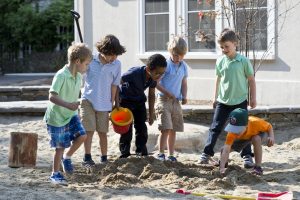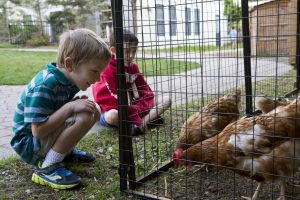 When visiting families see the new playground at The Fessenden School, one thing stands out right away: It doesn’t look anything like a playground—not the ones they grew up with, anyway.
When visiting families see the new playground at The Fessenden School, one thing stands out right away: It doesn’t look anything like a playground—not the ones they grew up with, anyway.
Fessenden’s playground has no slides, swings, or monkey bars. In fact, it has nothing you would recognize as traditional playground equipment.
“A traditional playground tend to foster chaos: a lot of running, a lot of chasing. We wanted to design something that would provide a very different opportunity for children,” says Keith Fortier, a Fessenden Kindergarten teacher who served on the School’s Playground Committee. “Especially in the greater Boston area, that’s all children play on. We wanted something that would be totally different.”
Mission accomplished. Fessenden’s playground is so totally different, the term “playground” hardly applies.
“We tend to use the term ‘playscape’ rather than “playground.’ We like to think of it as setting the stage for play,” Keith says. “Our goal isn’t recess. Our goal isn’t for them to just burn energy. Our goal is that they would be drawn into something far more meaningful.”
Keith and the rest of the Playground Committee set out to redefine the playground for the modern world in 2014. They unveiled their design in a ceremony this fall.
The Elements of a Playscape
To a passing observer, Fessenden’s playscape appears to be just a peaceful, well-tended garden. But look closer. You’ll notice a gentle, man-made stream meandering through the middle, a deep sand pit, and an intriguing variety of objects scattered throughout. These are the “loose parts” Fessenden’s students use to bring the playground to life.
 A swing or a slide can only be used one way, Keith points out. “We wanted to fill a playground with things that have infinite possibilities, that can be used any way the children imagine they can be used.”
A swing or a slide can only be used one way, Keith points out. “We wanted to fill a playground with things that have infinite possibilities, that can be used any way the children imagine they can be used.”
The loose parts include items like logs, sticks, shovels, buckets, large blocks, small rocks, bamboo sticks, tools, clipboards, cones, sponges, pieces of rope—and the list goes on. The teachers at Fessenden introduce new loose parts into the playground regularly, varying them with the seasons.
“When we fill it with all this stuff, what we’re really filling it with is potential,” Keith says.
21st Century Learning
Like many of the teachers at Fessenden, Keith believes that, for children, play is more than fun and games. Through play, children learn to make sense of the world, experiment to solve problems, and cooperate with each other. So while the boys at Fessenden have a blast using the playscape, the Playground Committee’s goals went beyond that.
The driving idea behind the design of the new playground is to use play to help boys develop the skills they’ll need to succeed in the 21st century. This is easier said than done, Keith points out; technology is reshaping the world so quickly, it’s nearly impossible to predict what the world will be like when Fessenden’s Pre-K and Kindergarten students reach adulthood.
“At least 80 percent of them are going to work in a career, maybe even a field, that doesn’t exist right now,” Keith observes.
But even without specifics, he says, “There are some things that we know are going to make them successful down the road”:
- How to communicate effectively with peers and authority figures.
- How to contribute to a team.
- How to bounce back when things go poorly.
- How to learn quickly and adapt to changing circumstances.
These are the skills the new playground was designed to teach.
An Example of How the Playscape Teaches
Fessenden’s playscape doesn’t have the traditional six-inch deep sandbox. Instead it has, in Keith’s words, a “massive sand pit” 2 1/2 feet deep. As Keith describes it, it’s the perfect setting for problem-solving play.
Imagine a group of boys making a giant hole in the sand, spreading sticks across it to form a cave they can hide in. When the sticks are too short, they have a problem to solve. Do they find different objects to span the gap or do they make the hole smaller? Whose job is it to find different objects and whose job is it to dig?
“The playground creates situations where the boys have to adapt and communicate with their peers to solve real-world problems,” Keith says. “That’s the philosophy behind the playground.”
Can’t imagine a playscape?
When Keith describes the new playscape to people, he finds they usually have trouble picturing it in their minds. If you’re interested in gaining a better understanding of how it helps boys learn, he invites you and your family to come see for yourselves.
“Come and watch what happens to a group of boys when they’re huddled over something that they feel is significant. Hear how they talk and hear how they work together to solve problems, because when you see it happening, it’s undeniable,” he says. “They’re having experiences when they’re 4 and 5 years old that mirror what they’re going to be doing when they’re 30 and 40 years old.”
While you’re visiting the playscape, make the most of your time on campus with a free copy of the Pre-K & Kindergarten Private School Visit Checklist.




